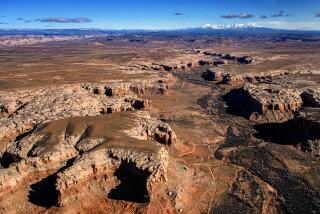Land Deals Help to Save Maine’s North Woods
PORTLAND, Maine — Suddenly, like a wind-whipped wildfire, a wave of conservation is spreading across Maine’s North Woods.
More than 1.6 million acres of the Northeast’s largest contiguous forest, from the Quebec border to Hancock County, 150 miles to the east, are in line for protection, either through outright purchase or through easements involving sale of development rights.
Conservation easements--becoming the favored means of protecting land because they stretch preservation dollars further than conventional land buys--have been used elsewhere in the country, but nothing matches the scale of these recent deals.
“Maine is playing a leadership role,” says Alan Hutchinson, executive director of the Forest Society of Maine.
In June, Gov. Angus King announced the first phase of the West Branch Project, which ultimately seeks to preserve 656,000 acres north of Moosehead Lake. The plan includes conservation easements, plus some outright land purchases. The first phase, 67,000 acres north of Moosehead Lake, will cost $8 million from state, federal and private sources.
An even bigger easement package surfaced last year when the Pingree family, which has owned large tracts of Maine timberland for seven generations, agreed to sell development rights to 755,000 acres, about the size of Rhode Island, for $30 million to the New England Forestry Foundation, based in Groton, Mass.
The parcels, some contiguous and others scattered far and wide, add up to a lot of land: about 8% of the total acreage of Maine, the nation’s most heavily forested state.
Other major deals include the $35-million sale of 185,000 acres along the St. John River to the Nature Conservancy in December 1998 and the state’s acquisition last spring of a 20,000-acre conservation easement on Nicatous and West lakes in Hancock County, 50 miles north of Acadia National Park on Maine’s Atlantic coast.
The North Woods is more than 10 million acres of sparsely populated territory teeming with moose and laced with mountains, streams and pristine lakes and ponds. It is also pocked with clear-cuts and crisscrossed by logging roads, an industrial forest that feeds raw material to paper mills and sawmills.
Only a small part of the North Woods is in public hands. The crown jewel is 200,000-acre Baxter State Park, including Mt. Katahdin, which the late Gov. Percival P. Baxter bought and donated to the state in various parcels from 1931 to 1962.
The preservation projects have come at a dizzying pace over the last two years, helped in part by the strong economy--private donors are more willing to open their wallets, and more government money is available for land acquisitions.
But they are also driven by the forest’s changing ownership. For most of the last century, a handful of pulp and paper companies showed little inclination to sell the huge tracts of forest that guaranteed timber for their mills.
Intensifying competition, however, prompted some companies to sell land to free capital for mill modernizations. New buyers, including land companies, investment trusts and pension funds, found they could realize ready money--and retain the land--by selling off development rights.
Timberland currently fetches roughly $200 an acre. By contrast, development rights to the Pingree lands, among the region’s most valuable, cost just over $37 an acre.
Easement proponents say their strategy affords protection while keeping land on the tax rolls, enabling logging to continue and maintaining public access for hunting, fishing and canoeing.
Not everyone is happy with the easements strategy. Property-rights advocates, for example, fear that easements threaten rural economies and ultimately pave the way for public ownership.
“You’re stripping the value out of the land,” laments Mary Adams, an activist from Garland. “Its value is there because of what it can be used for. By restricting that use, you’re taking away its vitality and its potential.”
Also skeptical, but for different reasons, are some environmental activists whose goals range from a ban on clear-cutting to creation of a Maine Woods National Park the size of Connecticut in which all logging would be barred.
The group leading the campaign for a national park--RESTORE: The North Woods--has no quarrel with conservation easements but worries the easements could drain support for the proposed park.
“The only thing that would be bad about these recent deals is if they make people believe we have solved the problem and can forget about the Maine woods,” says Michael Kellett, RESTORE’s executive director.
Others question the wisdom of paying large sums to owners for land that shows little sign of development interest even for lakeside cabins, much less marinas and condos.
John Williams, executive director of the Land Use Regulation Commission, which oversees development in the region, acknowledges that most of the permit requests filed with his agency involve the popular Rangeley and Moosehead regions.
But Williams is convinced that development pressures are growing around the lesser-known lakes in the heart of the North Woods. It’s only a matter of time, he says.
*
On the Net:
The New England Forestry Foundation: https://www.neforestry.org
RESTORE: The North Woods: https://www.restore.org
More to Read
Sign up for Essential California
The most important California stories and recommendations in your inbox every morning.
You may occasionally receive promotional content from the Los Angeles Times.










